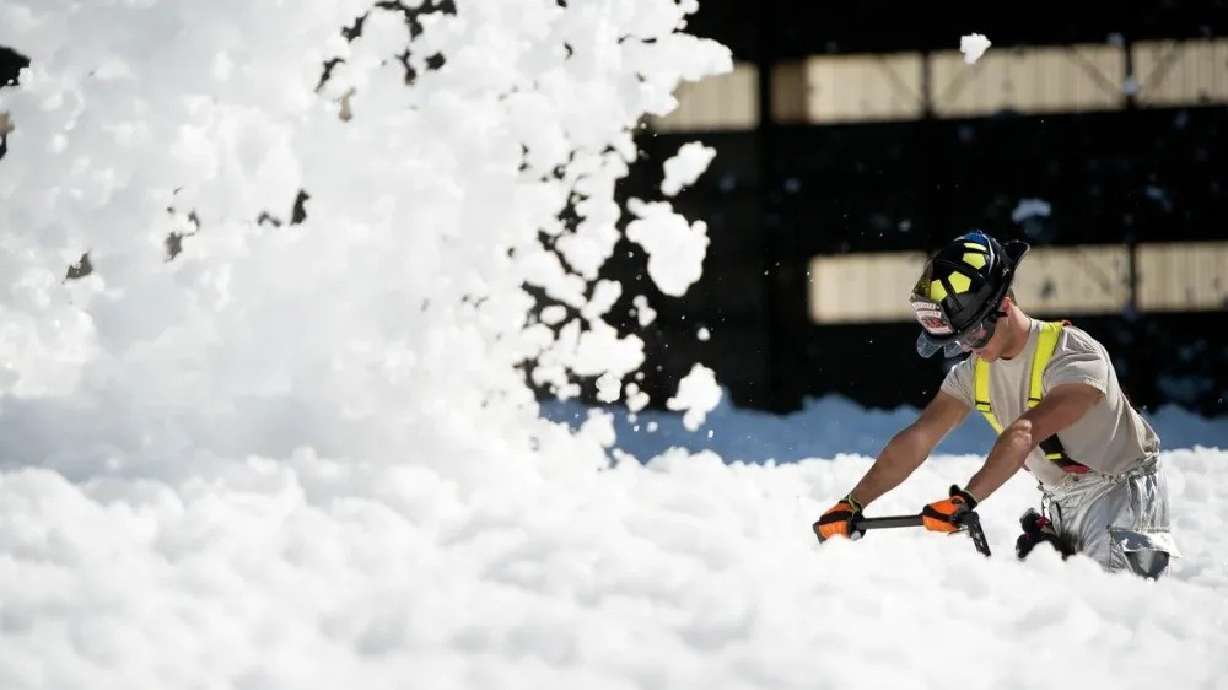Estimated read time: 4-5 minutes
This archived news story is available only for your personal, non-commercial use. Information in the story may be outdated or superseded by additional information. Reading or replaying the story in its archived form does not constitute a republication of the story.
SALT LAKE CITY — U.S. military installations across the globe are undergoing a transition from using environmentally damaging firefighting foam to a new compound that poses less risk to operators and the land.
"We had to get rid of all this stuff because it's bad for the environment, it's bad for people, and it's persistent," said Joe Bushman from Hill Air Force Base fire and emergency services. "This stuff, it just lasts forever."
Aqueous film forming foam, or AFFF, has been used since the 1960s to snuff out difficult fires, involving petroleum or other flammable liquids, and has been super effective. And while it is credited with saving lives, the health effects on front-line workers appear to be troubling.
The problem is, the foam contains per- and polyfluoroalkyl substances, or PFAS, a class of chemicals that don't readily break down in nature, and are harmful to health, according to developing research.
Another study found "firefighters using aqueous film-forming foams have unacceptably elevated blood levels" of per- and polyfluoroalkyl substances, which can cause health problems.
Emerging chemical program officials issued a risk alert to the Department of Defense in 2011, warning them the firefighting foam posed risks to human health and the environment. That alert went unheeded, because it lacked endorsements from a governance council.
In July 2015, as these chemicals started to show up in drinking water around the country, the Air Force fire chief halted the near-daily tests of the foam system, and ordered sealed units be installed on trucks, so they wouldn't require discharge for verification.
It wasn't until 2020, however, that the Department of Defense set a goal of moving away from the foam by Oct. 1, 2024. At that time, there was no approved substitute. Finally in September 2023, a new product — fluorine-free foam — was approved for use, and the military began the process of distributing hundreds of thousands of gallons of foam concentrate to locations around the world.
"We started receiving product probably at the end of February, beginning of March," Bushman said, right around the time when hangars were required to lock out their aqueous film forming foam systems. The old foam was removed from all tanks, which were then cleaned so no residue remained, and the waste was transported off-site.
The new foam takes one-and-a-half to two times longer to put out fires, according to Bushman, but he has no concerns "from the end-user standpoint." The firefighters have not yet received the green light to start testing and training with the replacement.
Base Fire Chief Barry Goff, for the Utah Air National Guard, said they have not yet received the new product, but "are excited about the new tech," and are getting ready through training.
"We fully expect to hit the Oct. 1 target," Goff said.
The last time Hill Air Force Base had to deploy the aqueous film forming foam, was when an F-35A Lightning II fighter jet crashed in October 2022. Goff has been the fire chief since 2006, and said there have been no emergency uses since he's been there.
Col. Jason Wilde, Utah National Guard land commander, said there was one accidental discharge in 2020 that required "all PFAS laden liquid stored until federal funding could be obtained."
Remediation efforts
National Guard environmental program manager Erik Sewell said sites testing positive for per- and polyfluoroalkyl substances contamination have been identified, and they are in the "beginning stage of remedial investigation."
Those sites include acreage by the Salt Lake City International Airport, the Wendover Airfield and the E.J. Garn Aviation Complex in West Jordan.
In 2019, 11 areas at Hill Air Force base were recommended for per- and polyfluoroalkyl substances remedial investigation.
Effluent groundwater samples were collected in December 2020, where per- and polyfluoroalkyl substances concentrations "were found to exceed the EPA Lifetime Health Advisory," and in multiple sites the groundwater, which is discharged directly into the neighboring sewer districts, "may have been impacted to an extent that could create a potential hazard to human health," according to a 2023 study.
Because the worst cases are dealt with first and no drinking water has been impacted around these areas, EPA remedial project manager Rob Stites said the remediation timeline may be hampered by budgetary constraints, and the changing understanding of this vast chemical class.









